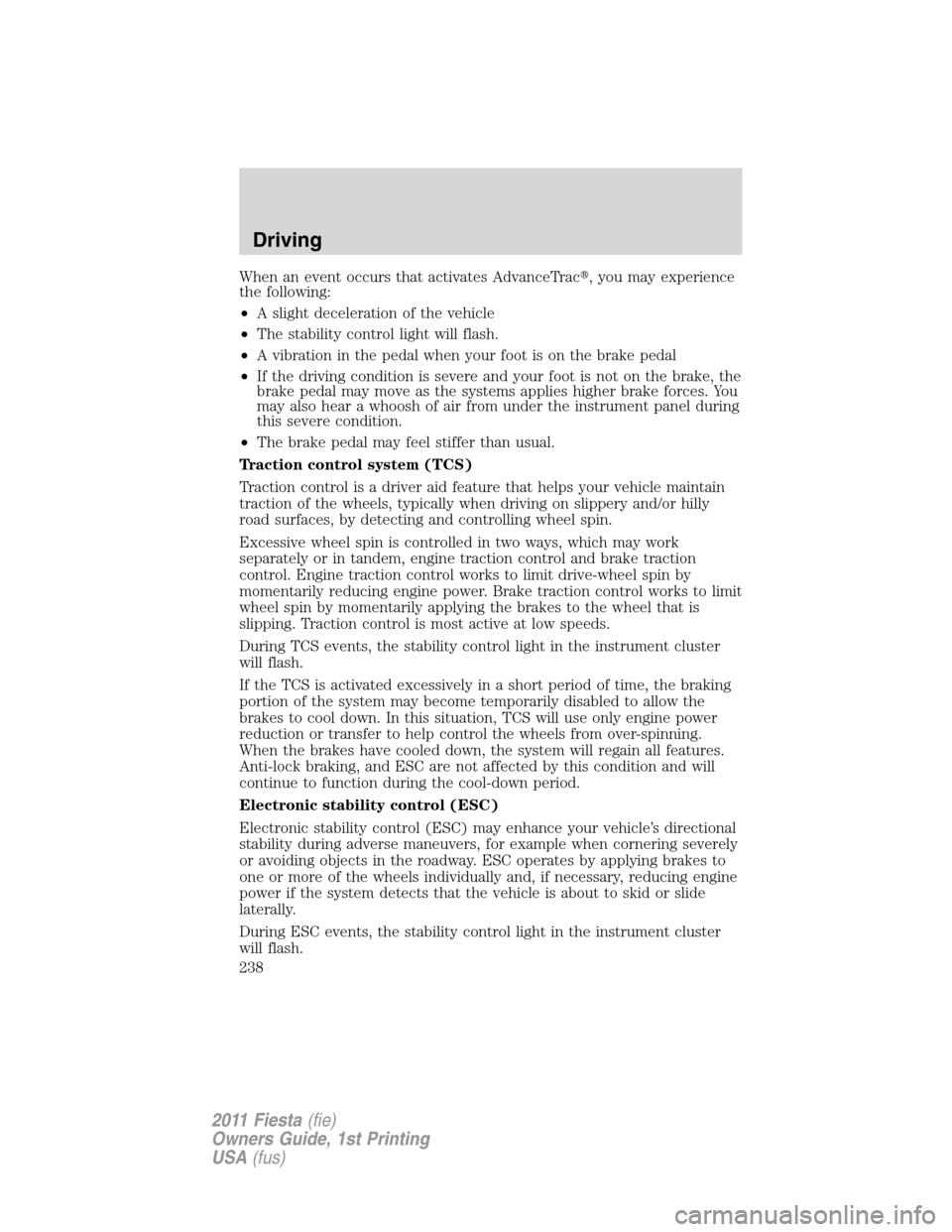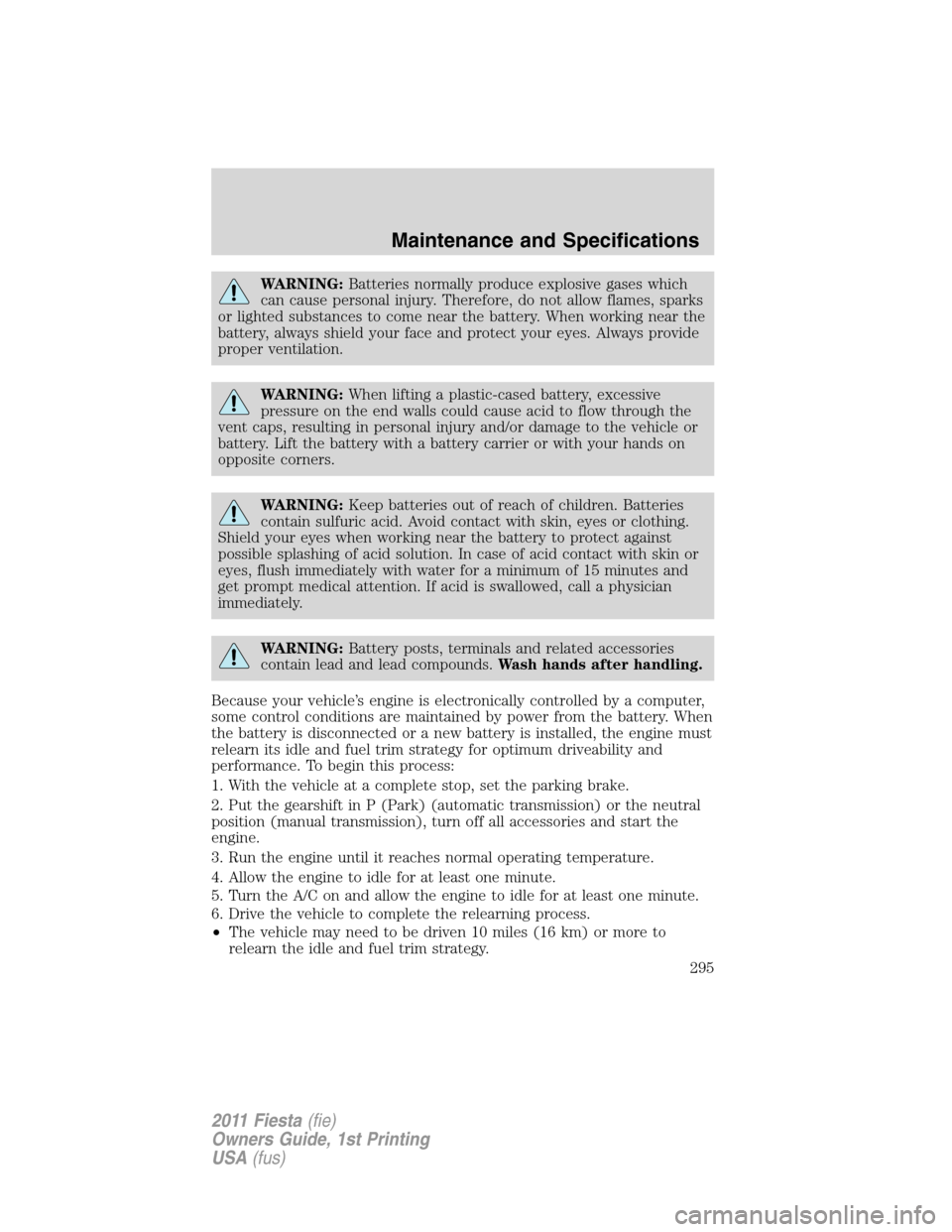Page 238 of 357

When an event occurs that activates AdvanceTrac�, you may experience
the following:
•A slight deceleration of the vehicle
•The stability control light will flash.
•A vibration in the pedal when your foot is on the brake pedal
•If the driving condition is severe and your foot is not on the brake, the
brake pedal may move as the systems applies higher brake forces. You
may also hear a whoosh of air from under the instrument panel during
this severe condition.
•The brake pedal may feel stiffer than usual.
Traction control system (TCS)
Traction control is a driver aid feature that helps your vehicle maintain
traction of the wheels, typically when driving on slippery and/or hilly
road surfaces, by detecting and controlling wheel spin.
Excessive wheel spin is controlled in two ways, which may work
separately or in tandem, engine traction control and brake traction
control. Engine traction control works to limit drive-wheel spin by
momentarily reducing engine power. Brake traction control works to limit
wheel spin by momentarily applying the brakes to the wheel that is
slipping. Traction control is most active at low speeds.
During TCS events, the stability control light in the instrument cluster
will flash.
If the TCS is activated excessively in a short period of time, the braking
portion of the system may become temporarily disabled to allow the
brakes to cool down. In this situation, TCS will use only engine power
reduction or transfer to help control the wheels from over-spinning.
When the brakes have cooled down, the system will regain all features.
Anti-lock braking, and ESC are not affected by this condition and will
continue to function during the cool-down period.
Electronic stability control (ESC)
Electronic stability control (ESC) may enhance your vehicle’s directional
stability during adverse maneuvers, for example when cornering severely
or avoiding objects in the roadway. ESC operates by applying brakes to
one or more of the wheels individually and, if necessary, reducing engine
power if the system detects that the vehicle is about to skid or slide
laterally.
During ESC events, the stability control light in the instrument cluster
will flash.
Driving
238
2011 Fiesta(fie)
Owners Guide, 1st Printing
USA(fus)
Page 244 of 357

Overdrive cancel with grade assist is designed to provide optimal gear
selection in hilly terrain or mountainous areas. It is recommended that
you return to D (Drive) on flat terrain to provide the best fuel economy
and transmission function.
To return to D (Drive), press the transmission control switch again.
•The grade assist lamp in the instrument cluster will not be illuminated.
•The transmission will operate in gears one through five.
L (Low)
This position:
•Provides maximum engine braking.
•Will downshift to the lowest available gear for the current vehicle
speed; allows for first gear when vehicle reaches slower speeds.
Hill start assist (HSA) system (if equipped)
The hill start assist (HSA) system makes it easier to pull away when the
vehicle is on a slope without the need to use the parking brake. When
HSA is active, the vehicle will remain stationary on the slope for two to
three seconds after you release the brake pedal. During this time, you
have time to move your foot from the brake to the accelerator pedal and
pull away. The brakes are released automatically once the engine has
developed sufficient drive to prevent the vehicle from rolling down the
slope. This is an advantage when pulling away on a slope, for example
from a car park ramp, traffic lights or when reversing uphill into a
parking space.
WARNING:HSA does not replace the parking brake. When you
leave the vehicle, always apply the parking brake and select P
(Park).
Using HSA
The HSA system is activated automatically when the vehicle is stopped
on a slope greater than four degrees. HSA operates with the vehicle
facing downhill if reverse gear is selected.
WARNING:You must remain in the vehicle once you have
activated HSA.
Driving
244
2011 Fiesta(fie)
Owners Guide, 1st Printing
USA(fus)
Page 245 of 357

WARNING:During all times you are responsible for controlling
the vehicle, supervising the HSA system and intervening, if
required.
Activating HSA
1. Press the brake pedal to bring the vehicle to a complete standstill.
Keep the brake pedal pressed.
2. If the sensors detect that the vehicle is on a slope, the HSA system
will be activated automatically in D (Drive) uphill or R (Reverse)
downhill.
3. When you remove your foot from the brake pedal, the vehicle will
remain on the slope without rolling away for approximately two to three
seconds. This hold time will automatically be extended if you are in the
process of driving off.
4. Drive off in the normal manner. The brakes will be released
automatically.
Note:If the engine is revved excessively, HSA will be deactivated.
Deactivating hill start assist
To deactivate HSA, perform one of the following:
•Apply the parking brake.
•Drive off uphill without re-applying the brake.
•Wait for two to three seconds until the HSA system deactivates
automatically.
•If hill start assist is active in D (Drive), select R (Reverse).
•If hill start assist is active in R (Reverse), select N (Neutral).
Note:The HSA warning lamp in the
instrument cluster momentarily
illuminates when the ignition is
turned on. If a malfunction is
detected in the HSA system, HSA will be deactivated and this warning
lamp will appear on the instrument cluster.
If your vehicle gets stuck in mud or snow
If your vehicle gets stuck in mud or snow, it may be rocked out by
shifting between forward and reverse gears, stopping between shifts in a
steady pattern. Press lightly on the accelerator in each gear.
Do not rock the vehicle if the engine is not at normal operating
temperature or damage to the transmission may occur.
Driving
245
2011 Fiesta(fie)
Owners Guide, 1st Printing
USA(fus)
Page 249 of 357
DRIVING THROUGH WATER
If driving through deep or standing
water is unavoidable, proceed very
slowly especially when the depth is
not known. Never drive through
water that is higher than the bottom
of the wheel rims (for cars) or the
bottom of the hubs (for trucks).
When driving through water, traction or brake capability may be limited.
Also, water may enter your engine’s air intake and severely damage your
engine or your vehicle may stall.Driving through deep water where
the transmission vent tube is submerged may allow water into the
transmission and cause internal transmission damage.
Once through the water, always dry the brakes by moving your
vehicle slowly while applying light pressure on the brake pedal.
Wet brakes do not stop the vehicle as quickly as dry brakes.
Driving
249
2011 Fiesta(fie)
Owners Guide, 1st Printing
USA(fus)
Page 259 of 357
Fuse/Relay
LocationFuse Amp
RatingProtected circuits
F29 10A** A/C clutch solenoid and relay
F30 30A** Not used (spare)
F31 20A** Low beam relay
F32 20A** BCM – battery saver, horn
F33 30A** BCM – rear window defroster
F34 — Not used
F35 — Not used
F36 — Not used
F37 — Not used
F38 — Not used
F39 — Not used
F40 — Not used
R1 — Not used
R2 — Not used
R3 — Not used
R4 — High beam relay
R5 — PCM relay
R6 — Daytime running lamp
R7 — Engine cooling fan relay
R8 — Starter inhibit relay
R9 — A/C clutch relay
R10 — Reverse light relay
R11 — Coil pack relay
R12 — Low beam relay
R13 — Heater blower relay
*Cartridge fuses **Mini fuses
Roadside Emergencies
259
2011 Fiesta(fie)
Owners Guide, 1st Printing
USA(fus)
Page 282 of 357
ENGINE
Engines are more efficient when they are clean because grease and dirt
buildup keep the engine warmer than normal.
When washing:
•Take care when using a power washer to clean the engine. The
high-pressure fluid could penetrate the sealed parts and cause
damage.
•Do not spray a hot engine with cold water to avoid cracking the
engine block or other engine components.
•Spray Motorcraft�Engine Shampoo and Degreaser (ZC-20) on all
parts that require cleaning and pressure rinse clean. In Canada, use
Motorcraft�Engine Shampoo (CXC-66-A).
•Never wash or rinse the engine while it is hot or running; water in the
running engine may cause internal damage.
•Never wash or rinse any ignition coil, spark plug wire or spark plug
well, or the area in and around these locations.
•Cover the highlighted areas to prevent water damage when cleaning
the engine.
Cleaning
282
2011 Fiesta(fie)
Owners Guide, 1st Printing
USA(fus)
Page 289 of 357
WARNING:To reduce the risk of vehicle damage and/or
personal burn injuries, do not start your engine with the air
cleaner removed and do not remove it while the engine is running.
OPENING THE HOOD
1. Inside the vehicle, pull the hood
release handle located under the
instrument panel.
2. Raise the hood slightly. Then push the hood latch release lever,
located under the front center of the hood, to the left.
3. Lift the hood and support it with
the prop rod.
Lower the hood and allow it to drop for the last 8-11 inches (20-30 cm).
Maintenance and Specifications
289
2011 Fiesta(fie)
Owners Guide, 1st Printing
USA(fus)
Page 295 of 357

WARNING:Batteries normally produce explosive gases which
can cause personal injury. Therefore, do not allow flames, sparks
or lighted substances to come near the battery. When working near the
battery, always shield your face and protect your eyes. Always provide
proper ventilation.
WARNING:When lifting a plastic-cased battery, excessive
pressure on the end walls could cause acid to flow through the
vent caps, resulting in personal injury and/or damage to the vehicle or
battery. Lift the battery with a battery carrier or with your hands on
opposite corners.
WARNING:Keep batteries out of reach of children. Batteries
contain sulfuric acid. Avoid contact with skin, eyes or clothing.
Shield your eyes when working near the battery to protect against
possible splashing of acid solution. In case of acid contact with skin or
eyes, flush immediately with water for a minimum of 15 minutes and
get prompt medical attention. If acid is swallowed, call a physician
immediately.
WARNING:Battery posts, terminals and related accessories
contain lead and lead compounds.Wash hands after handling.
Because your vehicle’s engine is electronically controlled by a computer,
some control conditions are maintained by power from the battery. When
the battery is disconnected or a new battery is installed, the engine must
relearn its idle and fuel trim strategy for optimum driveability and
performance. To begin this process:
1. With the vehicle at a complete stop, set the parking brake.
2. Put the gearshift in P (Park) (automatic transmission) or the neutral
position (manual transmission), turn off all accessories and start the
engine.
3. Run the engine until it reaches normal operating temperature.
4. Allow the engine to idle for at least one minute.
5. Turn the A/C on and allow the engine to idle for at least one minute.
6. Drive the vehicle to complete the relearning process.
•The vehicle may need to be driven 10 miles (16 km) or more to
relearn the idle and fuel trim strategy.
Maintenance and Specifications
295
2011 Fiesta(fie)
Owners Guide, 1st Printing
USA(fus)